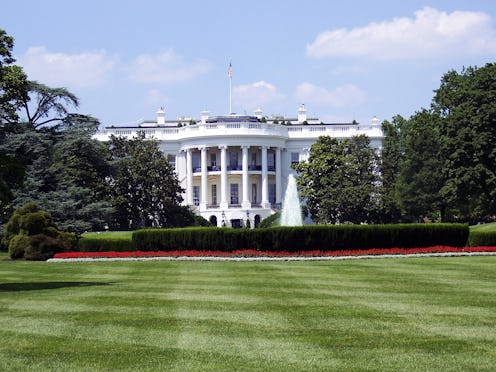Life
The History Of The First 100 Days Milestone
Try as you might, it's impossible to escape coverage of the sitting president's first 100 days in office. The milestone is often seen as an indication of how the administration is proceeding in its early stages, so it's probably no surprise to hear that the man who started the first 100 days was a president whose first term was going swimmingly — at least from a leadership perspective. (The country, on the other hand, was in less than ideal shape.) Although it might seem like a political institution, the concept of the first 100 days hasn't actually been around very long in the grand scheme of things. In fact, your grandparents might be able to remember when the idea was created.
It all began when Franklin D. Roosevelt took office in 1933. He had his work cut out for him: In the midst of the Great Depression, almost all the banks had closed, and by his inauguration in March, 13 million people were unemployed. It was one of the darkest points in American history, but Roosevelt promised to start work immediately, reforming the country within 100 days. Amazingly enough, that's exactly what he did. Within hours of his inauguration, he had his his entire cabinet sworn in at once, and in the following special session of Congress, his administration passed 15 landmark pieces of legislation, including the establishment of the Tennessee Valley Authority.
Technically, all this took place over the course of 105 days, and Roosevelt had been referring to the beginning of the special session of Congress rather than his own presidential term. But the idea of the first 100 days in office stuck around — it's a clear measurement for journalists, and as you've undoubtedly noticed from the news right now, politicians can use the date to pressure the commander in chief to get things done quickly. For more than 80 years now, it's been used as barometer for other presidents' administrations.
However, there are a few problems with the idea of the first 100 days. For one thing, thanks in part to an obedient Congress, Roosevelt set a ridiculously high bar. As FiveThirtyEight points out, no president has achieved the same level of productivity since then; even Obama, who came into office during a similar financial crisis, passed 11 bills in his first 100 days.
Furthermore, the early stages of an administration aren't always an indication of how it will proceed over the next four years. Bill Clinton, for example, had a rough start to his presidency, but he wound up serving two terms. Meanwhile, although Jimmy Carter had a strong first 100 days, he ended his administration on an unpopular note. Even John F. Kennedy wasn't exactly a fan of the first 100 days, once admitting in a campaign speech that "all this will not be finished in the first 100 days."
Of course, none of this has stopped anyone from analyzing Trump's first days in office. So far, he appears to have left much to be desired, with approval ratings stagnating around 40 percent. He failed to repeal the Affordable Care Act, and his executive orders regarding travel from some Muslim majority countries are tied up in courts (on top of which are the facts that many Americans don't want the ACA repealed and don't support the travel ban). A columnist for the New York Times called his first 100 days the "worst on record."
If other presidents' first 100 days are any indication, though, it remains to be seen how Trump's administration will go down in history. See you in another four years.
